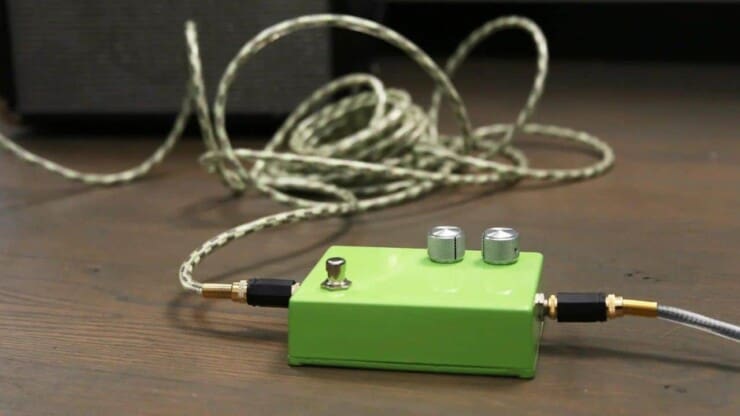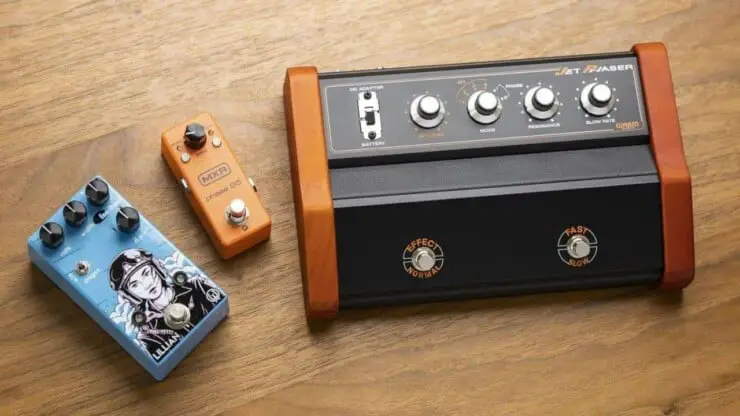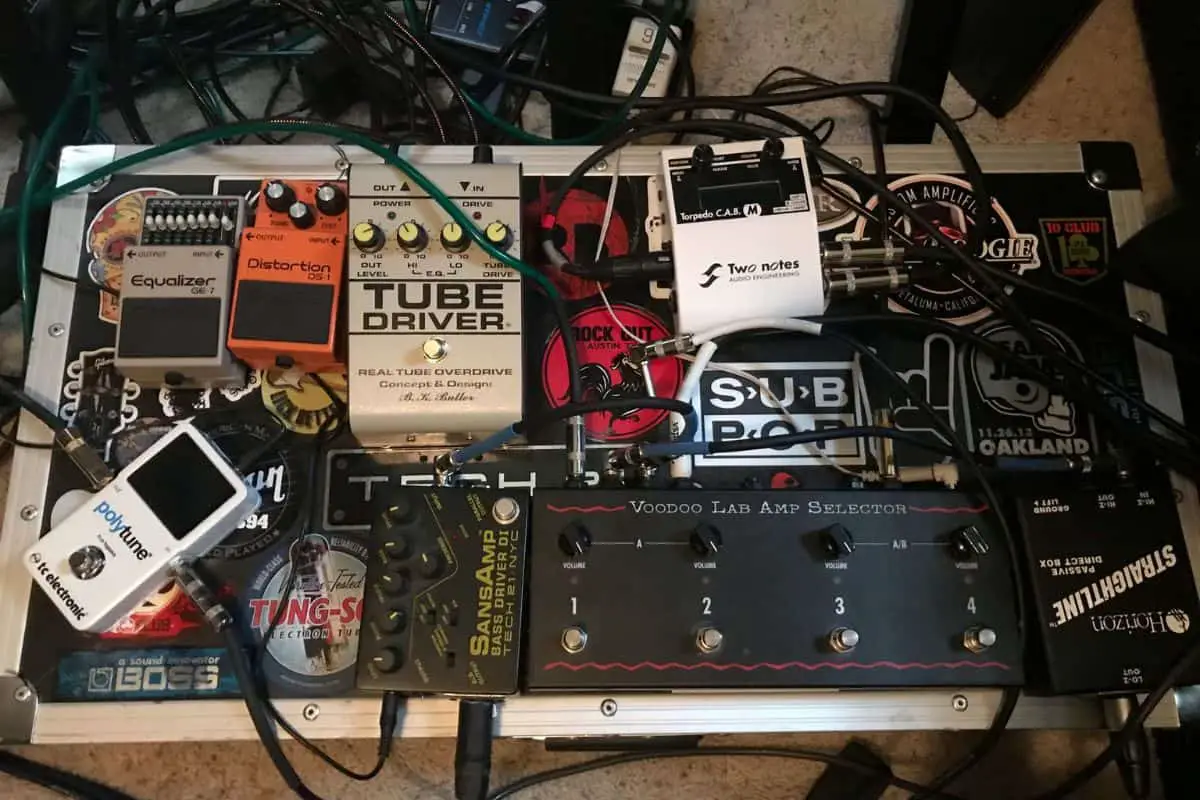Have you been struggling to get the classic sweeping effect of the guitar using a phaser because you don’t know where does phaser go in pedal chain? If so, then don’t worry because your issues will be resolved here.
Phaser goes in pedal chain at the very end. It is normally used after everything except delay and reverb. This way, the phaser effect can be applied to everything in the chain including EQ, distortion, filters, etc.
In this article, you’ll get to know all about phasers, what is a phaser, where does phaser go in pedal chain, how does it work, what circumstances are best for using a phaser, and a lot more. Stick around to know all the answers that you’re looking for!
What is a phaser pedal?
Before finding out where to put phaser in pedal chain, it’s important to know about the phaser effect. The phaser was a term originally used to refer to the popular tape flanging effect. In that effect, the two reels of the tape played the same signal, but one of them was slightly slowed by regular intervals. This often created a slow, whooshing effect that is now popularly known as the flanger.
In the late 60s, the Phaser effect really came into its own. The Uni Vibe effects pedal from the reputed Japanese manufacturer Shin-ei helped pioneer the phase-shift sound. It was possible thanks to the up-and-coming guitarist, Jimi Hendrix. By the early 70s, the Phaser effect had become a readily available portable guitar effect.
A phaser pedal essentially splits the signal into two. Then, it applies a series of all-pass filters to one of the copies. The two signals then get pushed through simultaneously, which results in them becoming completely out of phase at times and sometimes being completely in phase. If the former happens, you’ll likely hear a dip in the tone.
Meanwhile, if the latter happens, you’ll be hearing a spike. Understanding the differences will be important. The controls on the phaser pedal will allow you to influence when the dips and spikes happen. This will directly impact the quality of your guitar’s tone.
Controls of the phaser pedal
There are certain common controls that you will encounter when working with a pedal chain. To properly work with the phaser, you’ll need to know what they do.
- Speed/rate – Speed/Rate controls the speed of the Low-Frequency Oscillation (LFO), which controls the position of the all-pass filters of the phaser. A low rate will give you a slow open and close effect. Meanwhile, when you increase it, the tone could reach new levels of swirling, exciting sci-fi glory.
- Level – Often referred to as mix or wet/dry, this will control the amount of effect used vs. the dry input signal. If the depth is set to a minimum, you can get a faint suggestion of movement. However, if you set it to full, your guitar would be virtually unrecognizable.
- Depth – This will control the size of the peaks and troughs occurring in the all-pass filter. The bigger the size, the more warped the guitar would sound.
- Feedback – This will control the amount of output signal being fed back into the input. The term “feedback” essentially speaks for itself. Similar to when you’re holding a mic near a speaker, the signal will snowball into a wash of noisy overtones. It can sometimes be used for dramatic effects, giving the sound an otherworldly distorted quality.
How does a phaser pedal work?
A phase is essentially a position on a frequency spectrum. If you see a waveform, you’ll see numerous phases starting and ending as they’re hitting the zero-degree axis. The phase-shift sound can be achieved by mixing multiple identical signals together. One signal will be the dry input signal, while the other will have multiple peaks and troughs getting applied to the frequency spectrum.
This is known as an all-pass filter, which means any frequency can be boosted or cut. The position of the filter could be moved around gradually using an LFO. The altered signal can then be combined with the original.
Due to the movement caused by the LFO, the guitar will go in and out of phase. The frequency spectrums of the two signals will match, then unmatch, then match again, and so on. This is how the phaser pedal creates the swirling phaser effect.
Phasers can often use multiple all-pass filters in a chain, which is why some phasers work in multiple stages. This way, they are able to create more complex overtones. In certain cases, the output can even be partially fed back into the input. It generates feedback that is capable of adding another dimension to the sound.
Best settings to use on a phaser pedal
If you’re a new user of a phaser pedal, the dials can sometimes be a bit confusing. On most phaser pedals, you will find a speed knob, a depth knob, and a feedback knob. When using these knobs, you should understand that there aren’t any strict rules. Each guitarist’s experience will be different for the phaser pedals. This will depend on what your needs and wants are.

The speed knob will be a knob present on all phaser pedals, regardless of the brand or type you’re buying. The speed knob will control the peaks and troughs of the sound you normally hear. If you have the speed knob turned too high, the sound starts to appear to be extremely chaotic.
Many phaser pedals will come with a tap tempo, allowing you to click at the exact speed. You could even get your phaser’s speed to match the tempo of the song you’re playing. This option is not always possible, but it is recommended that you must choose a phaser pedal with this option.
Some phaser pedals that are as priced on the higher-end come with waveform selections and a wet/dry mix knob. If you’re looking to produce a vintage sound, these settings are believed to be the best –
- Rate – 3
- Depth – 8
- Feedback – 0
- Stages – 4
If you’re looking to get a modern rock sound, then these settings are believed to be the best –
- Rate – 7
- Depth – 4
- Feedback – 4
- Stages – Between 8 and 10
These settings can easily change. It’ll depend on the types of controls available in the phaser pedal and your personal preferences.
Where does phaser go in pedal chain?
As with many modulation effects, phaser pedals traditionally sit towards the back end of the pedal chain. It’ll go after everything except the ambient effects like delay and reverb. The answer to where to put phaser in pedalchain is after everything in the chain including distortion, filters, and EQ.
The first step in understanding where does phaser go in pedal chain will be to understand the signal flow of the effects pedals. Generally, the order of the pedals will go from the cleanest and quietest to the dirtiest and noisiest. It means that any pedals that can add gain or distortion must be placed at the end of the chain. For instance, a wah pedal needs to go before the distortion pedal, which will go before a delay pedal.
The next step would be to consider the specific function of different pedals in the chain. For instance, pedals that change the timbre of the sound (phasers or flangers) must be placed early in the chain. Meanwhile, pedals that add reverb or delay must be placed towards the end. This happens as the effects are best applied to the dry signal rather than the processed signals.
Similar to other modulation effects, a phaser pedal is located at the back end of the pedal chain. The reason why it must be used before everything except delay and reverb is that this way, the phaser can impact every element of the pedal chain. If you feel like you want to produce unique sounds, you can easily alter the sequence of elements. You can do something out of the box after stepping aside from the traditional layout. Some musicians prefer placing the modulation pedals in the effects look of the amp if there are any.
Therefore, the effect will be applied only to the cleanest version of the signal. However, this is essentially a matter of taste.
A digital phaser pedal normally features 4, 8, 10, and 12 stages, which allows you to experiment with phased sounds. An analog phaser, on the other hand, will come with fewer stages. The variety of the produced effects will be limited. Despite this mini shortcoming, many professionals opt for an analog phaser due to the warm, lifelike sound that it produces.
Regardless of the variant you’re choosing, you should pay close attention to the phase speed. This parameter will show how fast the wave rises and falls. Another key factor will be the depth feature, which will define the intensity of the phased waves.
How to use phaser pedals in modern music?
The phaser pedal is essentially a pedal that’ll allow you to unleash all types of creativity. However, although this is a pedal that you can release your creativity upon, there are guitarists who like to argue that there are appropriate times to use the pedal.
Meanwhile, some experts believe that the phaser pedal is essentially a creativity trump card. This means that your own creative ideas could trump any sort of conventional wisdom. Now comes the question, where can you use the phaser effect in modern music?
With melodic verse fills
Basically, you’ll be able to use the phaser pedal as a sort of thickening agent for making it seem like you are playing more notes than you actually are. For instance, if you’re playing 3-4 notes in a chorus, use the phaser pedal and give your chorus/bridge more detail. This will also give the music that you’re producing some depth to it.
With chord swells
Phaser’s peaks can sometimes create a type of sustain, which is sometimes identified as chord swell. Chord swells will work better when you are playing a track that is a bit slower. Fast-paced tempos can often clash with chord swells.
To add spice to your solos
The phaser pedal can even be used to give some depth to the soloing guitarist’s signal. This is very much like what you’d do with a boost, but without the extra gain. Instead of using any distortion in your solos, you can simply apply the phaser pedal and play fewer notes but with more emotion.
What type of music will be most suitable for phasers?
Phasers can often be used in almost any genre of music if you have enough creativity. With that said, there are specific genres where it’ll fit in a lot better than others.
For instance, classic rock is widely considered to be standard Phaser territory. Technical death metal isn’t probably going to be the genre where you’ll want to use a phaser pedal. Naturally, different pedals will have different intended purposes.
How you’ll be using the phaser pedal in your preferred genre depends on your playing style, too. It’s a known fact that Phasers normally work the best when you’re playing a few notes at a considerably slower tempo. For instance, slow chord arpeggios will work great with this effect, as it’ll give the pedal ample time to work each note you’re playing. Shredding a fast solo will be completely solo.
In theory, any slow part that isn’t highly saturated with notes benefits from a phaser effect that’s properly set up. It’ll work even better if you’re on a clean channel instead of a distortion or an overdrive.

One of the major mistakes that new users make in this effect is to crank everything up to the maximum. The first thing that’ll happen is the complete degradation of the signal, which will lead the user to think that there is something wrong with the pedal. The end result is the complete abandonment of the pedal and regret that it was used in the first place. You shouldn’t fall victim to the bad practice and approach the phaser pedal with caution.
When is the phaser pedal simply not going to work?
Anything that is being played at a faster tempo and includes many notes will be held back when being played with a phaser pedal. Heavy distortion will not work well with phasers, although overdrives will be completely fine if you’re using moderation.
Ultimately, everything will come down to how well you’re working with the phaser. Moreover, it’ll also depend on how good you’re matching the osculation of the signal with the music’s tempo. All things will come with time, experience, and trial and error. The phaser effect isn’t the type of effect that you could master overnight.
How bad can the phaser pedal mess up the tone if not applied properly?
The answer to that is – terribly. It does not affect the signal from the guitar to the extent that it distorts it in a way. However, a phaser will still change it in multiple ways. Adding in some “speed” using the knob could come with the same title, as it increases the number of dips you’re hearing in the tone. More dips will equal less signal intensity.
When using phasers, it’ll be easy to lose yourself in the effect. You can then start applying too much resonance and speed. This will be a big no-no if you’re looking to have a usable tone at the end of the day. Keeping that in mind, how you’ll be setting up the phaser pedal will ultimately depend on the type of music you’ll be playing.
Conclusion
Thank you for reading. Hopefully, now you know a lot more about phasers, what is a phaser, where does phaser go in pedal chain, how does it work, what circumstances are best for using a phaser, and a lot more. The phaser pedal normally goes at the end of the pedal chain. Generally, it gets used after everything except delay and reverb. This essentially means that the phaser effect could be applied to everything in the pedal chain including filters, distortion, and EQ. Although musicians love using the phaser effect, you should keep your emotions in check before overdoing the phaser can just as easily ruin your performance.
Image Credit:
Images: Instructables, Guitar Center



